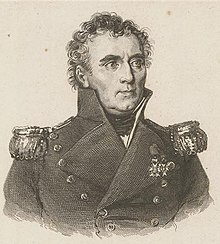Louis-Isidore Duperrey
This article needs additional citations for verification. (February 2014) |
Louis Isidore Duperrey | |
|---|---|
 | |
| Born | 21 October 1786 |
| Died | 25 August 1865 (aged 78) |
| Nationality | French |
| Occupation(s) | Naval officer, explorer |
Louis Isidore Duperrey (21 October 1786 – 25 August 1865) was a French naval officer and explorer.
Biography
Early life
Louis Isidore Duperrey was born in 1786.
Career
He joined the navy in 1802, and served as marine hydrologist to Louis Claude de Saulces de Freycinet aboard the Uranie (1817–1820). He commanded La Coquille on its circumnavigation of the earth (1822–1825) with Jules Dumont d'Urville as second. René-Primevère Lesson also travelled on La Coquille as a naval doctor and naturalist. On the return to France in March 1825, Lesson and Dumont brought back to France an imposing collection of animals and plants collected on the Falkland Islands, on the coasts of Chile and Peru, in the archipelagos of the Pacific and New Zealand, New Guinea and Australia.
During the voyage the ship spend two weeks in the Bay of Islands in the north of New Zealand in 1824 and visited for ten days on l'île d'Oualan,[1] now Kosrae Island, contemporary Federated States of Micronesia, that same year.[2] On the return voyage to France the ship sailed through the Ellice Islands (now known as Tuvalu).[3]
He was the first to put together on a map the whole Gilbert Islands archipelago, which are now part of Kiribati (with the name given to it by Admiral Krusenstern).[3] He was elected a Foreign Honorary Member of the American Academy of Arts and Sciences in 1861.[4]
Death
He died in 1865.
Legacy
The Australian eastern three-lined skink, Bassiana duperreyi (Gray, 1838), was named in his honour.[5]
See also
References
- ^ Suárez, Thomas (2004). Early Mapping of the Pacific: The Epic Story of Seafarers, Adventurers, and Cartographers Who Mapped the Earth's Greatest Ocean. Singapore: Periplus Editions. 224 pp. ISBN 978-0794600921.
- ^ "Coquille". Early shipping in New Zealand waters. Retrieved 10 November 2013.
- ^ a b Chambers, Keith S.; Munro, Doug (1980). "The Mystery of Gran Cocal: European Discovery and Mis-Discovery in Tuvalu". The Journal of the Polynesian Society. 89 (2): 167–198.
- ^ "Book of Members, 1780–2010: Chapter D" (PDF). American Academy of Arts and Sciences. Retrieved 9 September 2016.
- ^ Beolens, Bo; Watkins, Michael; Grayson, Michael (2011). The Eponym Dictionary of Reptiles. Baltimore: Johns Hopkins University Press. xiii + 296 pp. ISBN 978-1-4214-0135-5. ("Duperrey", p. 78).
